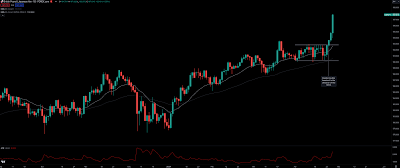March & April Recap
March was a brutal month, P&L wise. This was primarily due to mixed sentiment around interest rate cuts in the sense that the overall market was having trouble taking a directional bias. This trickled down to the signals that I look for, which resulted in a lot of false breakouts.
Instead of hammering away with the same methodology, I re-activated one of my "Strategy Testing" demo accounts to do some forward testing. More specifically, I asked myself how can I optimize the entries that I took as price broke out of daily ranges?
This question led to another realization - it's possible to be right but still not make any money. If the breakout is in the direction of the overall weekly and daily trend, my rule is to set take profit at 4.5x ATR. The idea here is to maximize the profit potential by riding the trend.
However, this is no good when I'm scratching most trades because price reverts before hitting the 4.5x ATR. Only very strong directional moves would have a chance of reaching the take profit, which would be a further subset of the breakouts that occur.
In my demo account, I experimented with setting "closer" take profit targets at 2x ATR. Here's the thought process.
ATR, or Average True Range, for a specific period looks a pair's daily volatility. If the daily ATR(5) of EURUSD is 100 pips, this would mean that this pair is capable of an average movement of 100 pips based the data consisting of the past five days.
If price suddenly spikes 200 pips, this is quite a deviation as it's double of the expected daily movement. When this positive deviation (in my favor) occurs, lock in the profit. This might be more optimal than letting price temporarily retrace in hopes that the trend will then resume.
Here's a visualization where setting a closer take profit could've been more profitable.
 |
| USDCHF 1-Hour |
- Price breaches the daily range boundary and then retraces back below it when the bar closes for the day
- Price breaches the daily range boundary and then completely rips, making any entry based off of the daily timeframe sub-optimal
 |
| GBPJPY Daily |
 |
| GBPJPY 1-Hour |
- Incorporate the hourly timeframe in order to identify micro-range breakouts to optimize entries
- Use buy and sell stops to plan trades, especially when I'm unable stare at the monitor for hours for price to play out
- Set closer take profit targets as booking some profits is better than scratching the trade; this allows for more consistent income generation as opposed to securing infrequent big wins
- Do not overtrade - if the price action on the hourly signal isn't good, then sit out